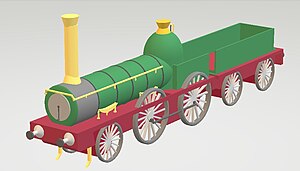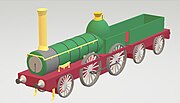| This article relies excessively on references to primary sources. Please improve this article by adding secondary or tertiary sources. Find sources: "GIP-1 to 8" – news · newspapers · books · scholar · JSTOR (January 2024) (Learn how and when to remove this message) |
| GIPR 1 to 8 | |||||||||||||||||||
|---|---|---|---|---|---|---|---|---|---|---|---|---|---|---|---|---|---|---|---|
 | |||||||||||||||||||
| |||||||||||||||||||
| |||||||||||||||||||
| |||||||||||||||||||
The GIP-1 to 8 were 8 locomotives produced by Vulcan Foundry in 1851, to operate on the Great Indian Peninsula Railway's line from Bombay to Tannah (now Thane). Three of these would reportedly pull India's first Train from Bori Bunder to Tannah on 16 April 1853.
The 2-4-0 type tender locomotives were ordered by the GIPR to operate on the first railway line in India. The Vulcan Foundry rotation numbers of these were from 324-331, while the working numbers were 680-687. These locomotives had a water capacity of 800 gallons (3028.33 Litres), and a tender capacity of 600 gallons (2271.25 Litres). They had 5 feet diameter driving wheels, a firegate area of 13.5 sq.ft (1.253 sq.m) and a heating surface of 777.25 sq.ft (72.2088 sq.m).
Three locomotives arrived at Bombay on the ship Charles in September 1852, along with carriages and six European drivers accompanying them. Since the locomotives were still in the process of being made ready in November that year, the trial journey conducted on 18 November 1852, was pulled by the E.B.Wilson manufactured Lord Falkland shunting Locomotive. They were expected to be made ready by February 1853.
Three of this series of locomotives were used to haul the first passenger train in India. They were ceremoniously named Sindh, Sultan and Sahib. They together pulled the 14 carriage train from Bori Bunder to Tannah (now Thane) on 16 April 1853.
The history of Sahib and Sultan is lost, however it is suggested, that they were later scrapped.
Gallery
| This section may contain information not important or relevant to the article's subject. Please help improve this section. (August 2024) (Learn how and when to remove this message) |
Here are some rough renderings of the locomotive type, created by consulting original blueprints. The render does not show the details of valve gear, instead only the connecting rod of the driving wheels. The controls in the driving cabin too aren't complete or accurate, referring only to a side view sketch of the locomotive.
-
 A very rough render of the Locomotive type GIP 1 to 8. Valve gear, and other details not shown. Made by referring to original blueprints.
A very rough render of the Locomotive type GIP 1 to 8. Valve gear, and other details not shown. Made by referring to original blueprints.
-
 Another view
Another view
Blueprint and other links
Original Blueprints at IRFCA website (provided by Graeme Pilkington) -
- Blueprint with details
- Blueprint handwritten
- Sketch
References
- "Vulcan Foundry Newton-le-Willows Complete Steam Locomotive Production Lists". enuii.org.
- P. K. Mishra. "THE FIRST RUNNING OF A RAILWAY LOCOMOTIVE IN INDIA" (PDF).
- ^ "GIPR 2-4-0 1851 dwg.jpg". www.irfca.org.
- ^ "GIPR 2-4-0 vertical boiler 1851 dwg.jpg". www.irfca.org.
- "GIPR 2-4-0 vertical boiler 1851 dwg.jpg". www.irfca.org.